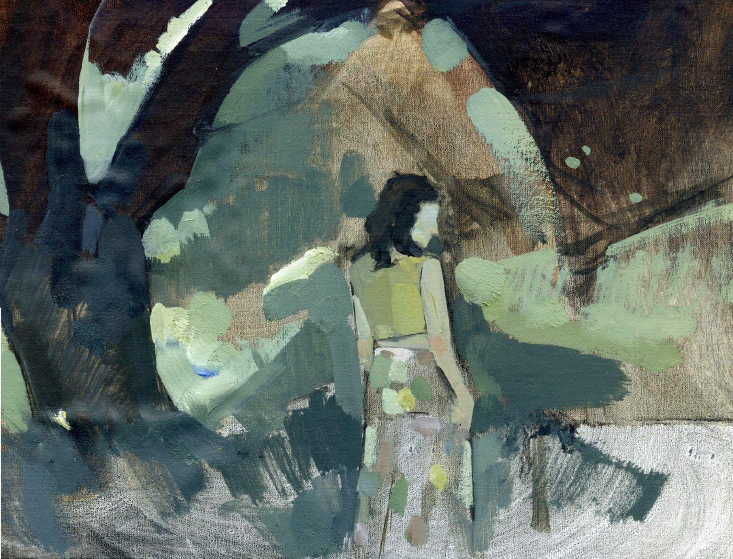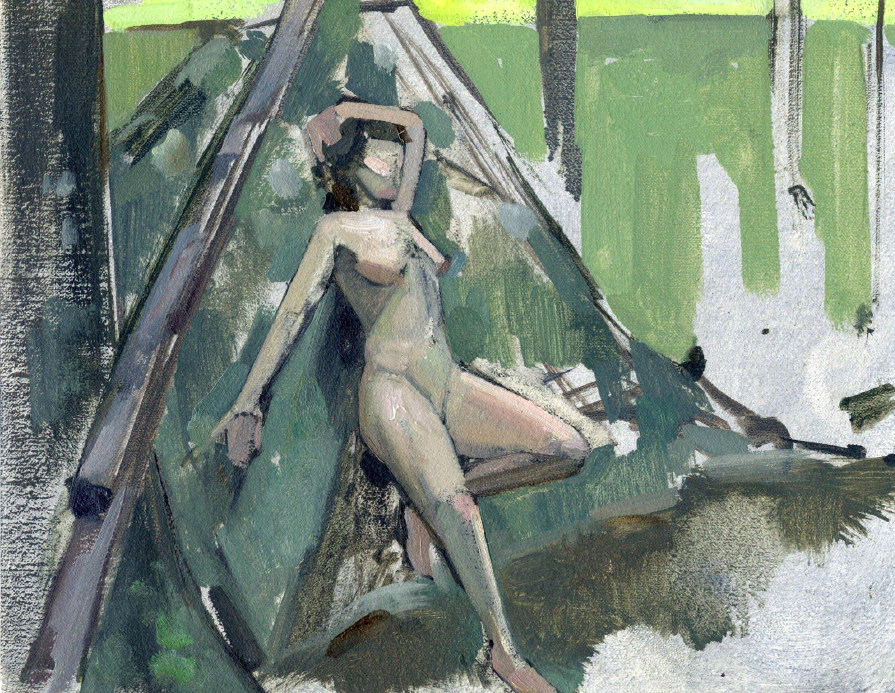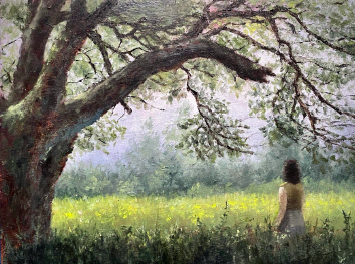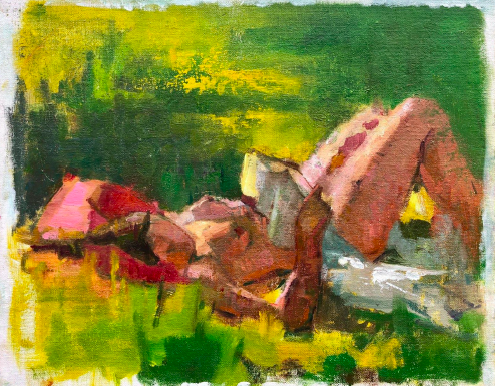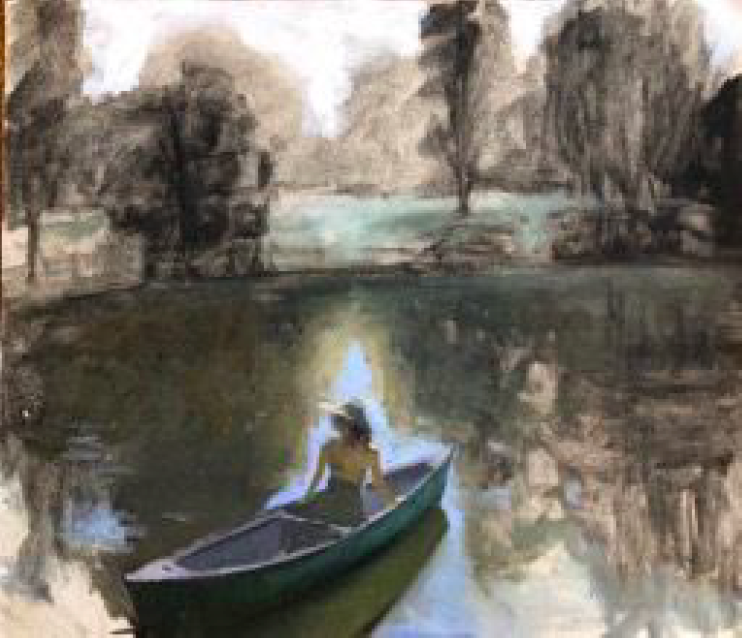Memories of Summer
by Michael Gormley
Hyeseung Marriage-Song, Girl Under the Apple Tree
Ever since stressed-out 19th century Parisian artists decamped to the countryside to escape the incessant demands and soul-sucking competition of their careers, painters have banded together and sought camaraderie in the refuge of nature. In hindsight, we have come to identify those regenerative forays into the wild not so much as pauses but pivots giving rise to stylistic invention. Perhaps we can attribute these advances to the temporary abandonment of individuate striving combined with a willingness to experiment “off-stage” in the company of supportive comrades.
Circa 2007 and in a similar existential crisis, painter and NYAE artist member Patricia Watwood and her husband Duncan Watwood cleared out their savings account and staked out a patch of paradise in the rolling foothills of Pennsylvania. Christened “Three Meadows”, the property is a former working farm long gone to seed. The acreage undulates with knee high grasses gently blowing in the forever breeze while centuries’ old arbors stand sentry along once planted fields silhouetting gnarly apples trees still tempting fruit. Down the hill and into a dank and shadowy ravine, a glassy beaver pond wants for skinny dipping. Seven years in and the property sported tent platforms, a kitchen shed and a combination out-house and rainwater shower stall---all designed and built by Duncan whose background is in theatre design. During the first week of August over the past five summers, the Watwoods have invited a group of artists from their inner circle to pitch tents, tend the campfire and paint and draw from the languid nudes Patricia artfully poses amongst the trees, streams, glacier boulders and tall grasses of this reclaimed Eden.
COVID kept the 2020 group small and serendipitously incestuous --if one traces prior academic affiliations and artistic mentors. In addition to Patricia Watwood, the invited artists included Chris Eastland, Kristin Kunc, Brooks Frederick , Lisa Lebofsky, Hyeseung Marriage-Song and this writer. Frederick, Lebofsky and Watwood are all New York Academy of Art (NYAA) alumni. I have been acquainted with one of the NYAA’s founders since the 1980s, hosted one of the institution’s inaugural student shows, and subsequently worked in the administration. Most of the participants had studied individually or in small groups in ateliers with master artists in addition to their formal education; Marriage-Song (Princeton), Kunc (PAFA) and Watwood (NYAA) had studied with Jacob Collins at the Water Street Atelier--a rear-guard studio education model that was soon copied throughout the United States . Frederick, Kunc and I had studied with Cedric and Joanette Eglei at the Cape School in Provincetown, MA. Eastland studied with Charles H. Cecil in Florence; Cecil had opened his atelier in 1991, and like Collins, was an early supporter of the atelier education revival.
In short, though allowing for the divergences noted above, the group present had all been attracted to and influenced by traditional studio practices with an emphasis on direct observation, representational drawing and narrative intent. In the case of Frederick, Kunc and this writer, realist representation is tempered with a colorist approach that favors a blocky, painterly style over a more tightly rendered linear technique. Lebofsky is a more recent NYAA graduate --- the teaching trend there has moved away from a strict observational realism to allow the primacy of conceptual development. Marriage-Song’s Ivy-League background likewise informs a more analytical, near cubist, approach to mark making, form building and the depiction of space. Eastland and Watwood remain the most classically pure with tightly composed works firmly rooted in direct observation and realist depiction.
Hyeseung Marriage-Song
Hyeseung Marriage Song, Baroque Line
Hyeseung Marriage Song, Three Tents and Jesus
Hyeseung Marriage Song, Green Triangle in Nature
Hyeseung Marriage-Song is best known for her large-scale figurative paintings and prints whose visual idioms toggle between resolution and fragmentation. Her last body of work, a contemporary response to the mythology of the golem, was an exploration of the themes of creativity, psychological incipience and the life of the artist. The work Marriage-Song produced at “Three Meadows” privileges a limited palette that reinforces a modernist plastic expression of form and space that is stacked, shallow, and at times reduced to flat patterns. Disrupting the classic “figure in a landscape” genre (whereby the figure predominates in a static stage-like setting), Marriage-Song subjects each compositional element to the same reductive expression— scaffolding a highly idiosyncratic and architectonic pictorial space balancing movement and structure.
“This was my fifth PA Paint Out,” Marriage -Song notes. “Every year I enjoy coming out and painting the nude in nature with my closest art friends. This year was by far my favorite year though, which might be strange to say in light of a global pandemic. I was starved for society and I felt the solace of nature much more acutely this year. Given the circumstances, it was really the old guard who came out, alums who know the ins and outs of the experience Patty (sic Watwood) so wonderfully curates. She puts together an amazing and collegial experience in Three Meadows-- from the models she chooses to the food menu she puts together. This year, all that included safety as well. In terms of the work I create during PA Paint Out, I think of my sketches very uncritically-- I look for a storyline for myself, and go for it. I don't think about "making a painting" so much as giving myself a non-critical space to uncover the next thing I might be interested in. “
Lisa Lebofsky
Lisa Lebofsky, PA Study
Prior to the pandemic, Lisa Lebofsky was a self-styled nomadic painter, moving from place to place (both stateside and abroad) collaborating with nature and people. Abandoning the gravitas of a sole base, her participation with the landscape becomes immediate—as each specific location and her relationship to it defines home. Forging that vital connection with place imbues her painting with a voracious hold on reality, offering a deeply felt and detailed sensuality (through intricately woven and layered surfaces) that viewers sensate on a visceral level. Less records of pastoral scenes, Lebofsky’s scene paintings are portraits of our emotional natures played out in our struggles and encounters with ourselves and others.
Lisa Lebofsky, PA Study
Lebofsky notes that, “…PA Paint Out is a rarefied experience encompassing the best aspects of being an artist: unencumbered time to create, isolation from the quotidian, creating side by side and jovially with art peers, and acres of inspiration. The off grid living allows for a streamlined existence of reveling in nature and pure art making. There is no shortage of time, beauty, inspiration, and optional solitude while surrounded by insightful and encouraging artists. The setting provided not just physical space, but mental space. This afforded artistic and personal growth through freedom of experimentation, no pressures from day to day needs or deadlines, and the paired down enjoyment of the invigoration that nature and other artists offer.”
Brooks Frederick
Brooks Frederick, Study
Brooks Frederick is a Louisiana raised, Brooklyn Based artist who has equal passions for creating works of contemplation and social advocacy. Watching Frederick work from the figure out-of- doors is akin to watching a sculptor slap clay on a wire armature. Big strokes of patchy, high- chroma pigment simultaneously give form and dissolve the studied figure—expressing with great effect the scintillating light of a summer day. Frederick’s plein air technique comes direct from Charles Hawthorne who perfected his own atmospheric style painting models posed on the beach under Cape Cod’s brilliant sun. Hawthorne eschewed drawing, claiming that “…one spot of color applied next to another” would provide all the drawing a painting needed. Also eschewing black from his palette, Hawthorne’s paintings, though luminous and light-filled, present the flattened, form-less appearance characteristic of the Impressionists. Frederick pushes tone back in, and re-introduces line, which lends his figures a sense of weight and volume while preserving outdoor light effects.
Brooks Frederick, PA Studies
Brooks Frederick, PA Studies
Frederick notes that the PA Paint Out is one of the creative highlights in his year. “It pairs the formal challenges of painting the live model under quickly changing light with the soul serving benefits of artist fellowship, campfire songs. and a little booze. I always come back renewed and energized. He adds, “At first, I questioned painting a beautiful model in an idyllic setting in time of social unrest. But as I began painting, I was quickly reminded of the healing potential of community and spending time with nature. I arrived at the camping site with neck and back pain from COVID-19 related stresses - and came back to NYC feeling healed and whole again.”
Patricia Watwood
Patricia Watwood, Summer Canoe
Unabashedly sentimental and a romantic to the last, Patricia Watwood is at her best staging and painting the model in bucolic out-door settings. All the better if she has a band of fellow-artists to work with. Although those present enjoy an easy camaraderie, the very near presence of another artist reinforces isolate practices. Though there is considerable back and forth “borrowing” ---the take is heavily edited --- further reinforcing each artist’s distinct style. Watwood is fast, very fast, and able to set down a fully realized composition while most are still fumbling with their paint tubes. By the time her colleagues have caught up to that stage, Watwood has made a good beginning on a narrative.
Patricia Watwood, Under the Apple Tree
In Watwood’s sanctuary garden, an easy and innocent beauty pervades. In the studio, Watwood practices a restrained and elegant classicism. In the field, she loses herself, as did French painters a century before, and morphs into a Fauve painter of fanciful idylls. Heightening bold colors with calligraphic brush work, she collapses the act of drawing and painting into a singularly brash act--as is nature herself on a sultry and hot August afternoon.
Chris Eastland
Chris Eastland, PA Drawings
Chris Eastland, PA Drawings
Chris Eastland is a classically trained portrait artist working mainly in oil and charcoal. He notes that, “I studied and taught portraiture in Florence under Charles Cecil for seven years during my late teens and early twenties. Going against type, Eastland’s appearance would lead you to believe otherwise; his thick mane of curly shoulder-length hair, aquiline nose, scruffy beard and ever-strumming guitar have earned him the hippie nick-name “Jesus” in the group. Yet his exquisitely detailed drawings evince years of studying the sight-size method expounded by Cecil and similar adherents of realism.
Chris Eastland, PA Drawings
In conservative studio practice, the site-sized method is employed as an exacting measuring technique aimed at realizing a near photographic realism. In portraiture, it is a sure path to capturing a likeness. In most instances, Eastland can deploy a spare linear arabesque to isolate and express the important landmarks of a scene and communicate its memory. More importantly however is what Eastland chose to leave out, and white space increasingly becomes the defining element of his drawings. The fecundity of white space is akin to the absence of color in a monochromatic work. Left empty, yet abundantly full of mystery and promise, the mind sees the details. The Japanese call this concept yohaku no bi and it was originally an artistic strategy found in Chinese landscape ink wash paintings. In the latter, clouds, mist, sky, and water were left unpainted and their presence suggested by the careful rendering of the surrounding landscape. Similarly, Eastland invites his viewers to participate in the creation of his drawings with just enough information to set them on the path to imagining.
Kristin Kunc
Kristin Kunc, The Haunting
Kristen Kunc is a storyteller. Her protagonists are fem fatales, if not outright seductresses, caught up in the quest for the accoutrements of femininity (luxurious garments, calm domesticity, and beautiful objects) while languorously negotiating their complicated connotations, entitlements, and unavoidable entrapments. The stories evolve as the viewer bears witness to their self-reflection—as they muse about what they are faced with and what they should and could become.
Kristin Kunc, Social Distancing
Kristin Kunc, Be Scared of the Dark
Kristin Kunc, Understudy
Having links to the Cape School and generally considered a colorist, Kunc’s foray into the field yielded grisaille tableaus of unusual veracity. Both day dream and nightmare combined, they are sexy and simple---though how she gets there may be largely happenstance. Kunc laments what a slow painter she is; working out of doors with a fidgety model Kunc works in anxious haste and is able to dash out only the most direct narrative elements. Prone to half-baked guesses and snap decisions, she consciously (or not) communicates more directly what she needs to say and why. As portals to semi-conscious longings and desires, we find these works to be objects bearing great truths
Kunc notes that this year the model and the setting had a very different impact on her than previous years. “Generally I would want to paint colorful fields or the morning mist; this go around I found myself portraying dark fears and fantasies that came out of the isolation and detachment associated with the global pandemic. And yet, the warm embrace of summer sunshine, the freedom of open grassy fields, and the baptismal cleansing of cool mountain water conspired to undo the dread and I felt safe, refreshed and reborn. Every year, but especially this year, I look forward to PA Paint out. I always feel as though it ‘gets me’.”

